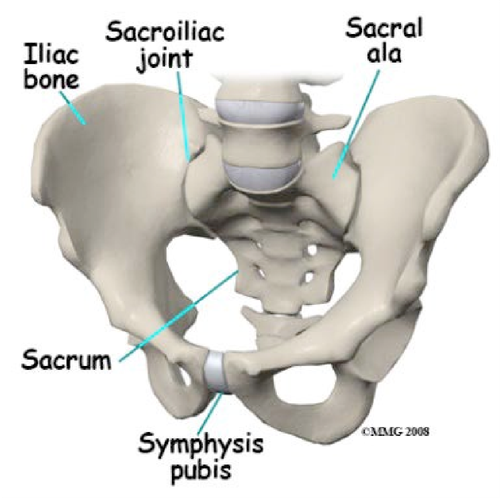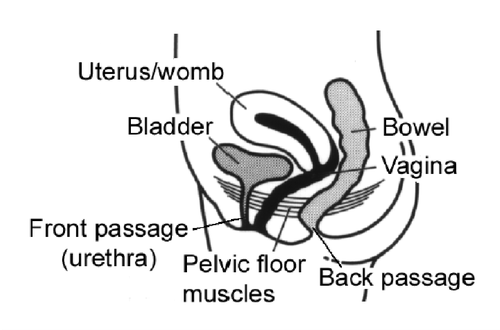Looking after your back and pelvis in pregnancy
This page gives you advice on how to look after your back and pelvis during pregnancy, to lessen any pain or prevent pain happening.
During pregnancy, changes to your body may cause you to have pain or discomfort in your lower back, inner thigh (top of legs), buttock, legs, sacroiliac joints or symphysis pubis (see Fig 1.).

What causes back or pelvic girdle pain?
- The muscles across your tummy, pelvic girdle (pelvis area), hip and the pelvic floor support the back and pelvis. These structures become gradually stretched as your baby grows. As a result, these muscles may not work as well as they did before.
- You may be affected due to your changing shape and weight.
- During pregnancy a hormone called relaxin is released. This makes your ligaments soften and become more flexible and can sometimes be the cause of your pain. Some people are more affected by this than others.
- Occasionally, the position of the baby can cause pain or discomfort.
What can I do to help myself?
- Keep your knees and feet together when, getting in and out of the car or getting in and out of bed.
- When getting out of bed, roll onto your side, keep your knees together and allow your feet to drop off the end of the bed. Push yourself up sideways with your arms into a sitting position.
- Sit down when you are getting dressed to minimise standing on one leg, such as when putting on trousers.
- When you are standing, try to make sure that weight is on both of your legs equally.
- When swimming, do not to do breaststroke if this makes your pain worse. Keeping your leg movements small when swimming can make you feel more comfortable.
- If you find using the stairs difficult, try taking one step at a time.
- Try not to cross your legs when sitting.
- Adopt a good sitting posture that supports your back, thighs and feet. Try not to slump.
- Sleeping on your side with a pillow between your knees and feet can make you more comfortable.
- When you do have to lift, make sure that you keep what you are lifting close to your body. Keep your back straight and bend your knees. Make sure that you carry the load evenly with both hands.
- Keep a good posture when standing; this will help to reduce the strain on your back.
Listen to your body
It is important to remain as active as possible within the limits of your pain.
If you do experience pain, listen to your body. Try to pace yourself and plan ahead so that you can minimise any activities which aggravate your pain. However, try to maintain a reasonable level of exercise where you can. It is recommended that pregnant women should aim to do around 2½ hours, of walking per week.
For more information on keeping active, please visit the following website: https://www.nhs.uk/pregnancy/keeping-well/
If you are concerned about your pain, please contact your midwife.
Exercises
There are 2 important muscle groups, the pelvic floor and the deep abdominal muscles, which provide stability to the pelvis and lower back.
1. Pelvic floor exercises
The pelvic floor muscles form a hammock at the base of your pelvis, spanning across the bottom of your spine (coccyx) to the bone between your legs (pubic bone).

To contract the pelvic floor, imagine you are trying to stop passing wind and at the same time trying to stop the flow of urine midstream. You should feel a sensation of ‘squeeze and lift’ as you close and draw up the back and front passages. Hold this for as many seconds as you can (up to 10 seconds). At the end of the hold there should be a definite feeling of ‘letting go’. It is best not to do this when passing urine.
It is recommended that 24 of these ‘squeeze and lift’ exercises are performed daily. Try doing 8 holds 3 times per day. It is important to practice the exercises in a variety of positions, lying, sitting and standing to ensure the muscle works well to support your pelvis. For more information, please see the ‘Pelvic floor exercises for women’ GHPI0259 leaflet.
2. Abdominal muscle exercises
It is also important to strengthen your abdominal muscles so they can support your bump.
- Place your hands over your lower tummy, under your bump.
- Breathe in and as you breathe out, gently squeeze your pelvic floor muscle.
- Draw in your lower tummy muscle away from your hands, pulling your tummy towards your back. This will be a small movement; you should not feel your tummy bulge or the sensation of bearing down.
- Hold steady for up to 3 normal breaths and then let the muscle relax.
- Repeat this exercise a maximum of 10 times, 3 times per day.
Try to contract these muscles to support your pelvis and lower back when doing any activities requiring effort. If you are concerned about pain, or you are not managing it well, do not hesitate to contact the pelvic health physiotherapy team listed in the next section.
Contact information
If you have any concerns, please contact your midwife, GP or your obstetric physiotherapist at the following hospitals:
Cheltenham General Hospital
Tel: 0300 422 3040
Monday to Friday, 8:30am to 4:30pm
Gloucestershire Royal Hospital
Tel: 0300 422 8527
Monday to Friday, 8:30am to 4:30pm
Further information
Pregnancy Related Pelvic Girdle Pain
This is available in different languages.